Crucial Safety Protocols to Ensure a Enjoyable and Secure Dance Area Experience at Occasions
Crucial Safety Protocols to Ensure a Enjoyable and Secure Dance Area Experience at Occasions
Blog Article
As planning an occasion with a dance floor, guaranteeing the safety of all attendees is crucial. A enjoyable and safe dance floor environment can enhance the overall enjoyment of the occasion. To attain this, occasion planners should implement key safety protocols that cover different aspects of the dance setting. These protocols not only safeguard guests but also foster a friendly atmosphere where all can feel at ease and have a good time.
One of the primary safety considerations is the physical space of the dance floor. It is important to ensure that the area is large enough to accommodate the expected number of guests. A crowded dance floor can lead to accidents, such as falls or collisions. Organizers should also inspect the flooring type to confirm it is suitable for dancing. Smooth surfaces, such as hardwood or vinyl, are ideal, while carpets can pose tripping hazards. Additionally, keeping the dance area free of obstacles, such as chairs or furniture, will help prevent injuries and allow for a more pleasant experience.
Lighting plays a significant role in establishing a safe dance floor setting. Proper lighting not only establishes the mood for the occasion but also helps guests navigate the space safely. Low lighting can make it difficult for dancers to perceive their surroundings, raising the risk of incidents. Therefore, organizers should use a mix of ambient and directed lighting to illuminate the dance floor sufficiently. Emergency indicators should also be easily visible, and planners should ensure that the illumination is adjustable to suit different types of music and dance genres.
Another important aspect of security on the dance floor is crowd management. Occasion staff should be prepared to monitor the dance space and ensure that guests are acting properly. This useful source includes tackling any instances of overcrowding or unacceptable behavior that could lead to issues. Additionally, having a designated area for guests to have breaks can help reduce fatigue and prevent accidents. Offering water stations nearby can also promote hydration, which is vital for keeping energy levels during dancing.
Ultimately, it is crucial to communicate safety guidelines to all participants. Before the occasion begins, planners should inform guests about the rules and guidelines for the dance floor. This can include reminders to be aware of their environment, honor personal space, and limit excessive drinking consumption. Providing clear guidelines can help foster a culture of security and responsibility among guests. By fostering an atmosphere where everyone is aware of safety measures, event organizers can guarantee that the dance floor remains a enjoyable and secure space for all participants.